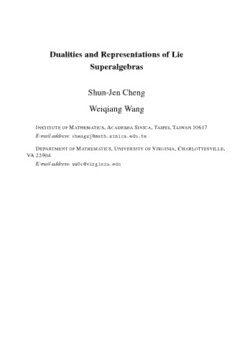
Dualities and representations of Lie superalgebras PDF
Preview Dualities and representations of Lie superalgebras
Dualities and Representations of Lie Superalgebras Shun-Jen Cheng Weiqiang Wang INSTITUTEOFMATHEMATICS,ACADEMIASINICA,TAIPEI,TAIWAN10617 E-mailaddress: [email protected] DEPARTMENTOFMATHEMATICS,UNIVERSITYOFVIRGINIA,CHARLOTTESVILLE, VA 22904 E-mailaddress: [email protected] 2000MathematicsSubjectClassification. Primary NSC. NSF. ABSTRACT. Abstracthere. Contents Preface ix Chapter1. LiesuperalgebraABC 1 §1.1. Liesuperalgebras: DefinitionandExamples 1 1.1.1. Basicdefinitions 2 1.1.2. ThegeneralandspeciallinearLiesuperalgebras 4 1.1.3. Theortho-symplecticLiesuperalgebras 6 1.1.4. ThequeerLiesuperalgebras 8 1.1.5. TheperiplecticandexceptionalLiesuperalgebras 9 1.1.6. TheCartanseries 10 1.1.7. Theclassificationtheorem 12 §1.2. StructuresofclassicalLiesuperalgebras 13 1.2.1. Abasicstructuretheorem 13 1.2.2. Invariantbilinearformsforglandosp 15 1.2.3. RootsystemandWeylgroupforgl(m|n) 16 1.2.4. RootsystemandWeylgroupforspo(2m|2n+1) 16 1.2.5. RootsystemandWeylgroupforspo(2m|2n) 17 1.2.6. Rootsystemandoddinvariantformforq(n) 17 §1.3. Non-conjugatepositivesystemsandoddreflections 19 1.3.1. Positivesystemsandfundamentalsystems 19 1.3.2. Positiveandfundamentalsystemsforgl(m|n) 21 1.3.3. Positiveandfundamentalsystemsforspo(2m|2n+1) 22 1.3.4. Positiveandfundamentalsystemsforspo(2m|2n) 23 1.3.5. Conjugacyclassesoffundamentalsystems 25 1.3.6. Oddreflections 26 §1.4. Highestweighttheory 30 iii iv Contents 1.4.1. ThePoincare´-Birkhoff-Witt(PBW)Theorem 30 1.4.2. RepresentationsofsolvableLiesuperalgebras 31 1.4.3. HighestweighttheoryforbasicLiesuperalgebras 32 1.4.4. Highestweighttheoryforq(n) 34 §1.5. Notes 36 Chapter2. Finite-dimensionalmodules 39 §2.1. Classificationoffinite-dimensionalsimplemodules 39 2.1.1. Finite-dimensionalsimplemodulesofgl(m|n) 39 2.1.2. Finite-dimensionalsimplemodulesofspo(2m|2) 41 2.1.3. Avirtualcharacterformula 41 2.1.4. Finite-dimensionalsimplemodulesofspo(2m|2n+1) 43 2.1.5. Finite-dimensionalsimplemodulesofspo(2m|2n) 46 2.1.6. Finite-dimensionalsimplemodulesofq(n) 48 §2.2. Harish-Chandrahomomorphismandlinkage 50 2.2.1. Supersymmetrization 50 2.2.2. Thecentralcharacters 51 2.2.3. Harish-ChandrahomomorphismforbasicLiesuperalgebras 52 2.2.4. Invariantpolynomialsforglandosp 54 2.2.5. ImageofHarish-Chandrahomomorphismforglandosp 56 2.2.6. Linkageforglandosp 59 2.2.7. Typicalfinite-dimensionalirreduciblecharacters 63 §2.3. Harish-Chandrahomomorphismandlinkageforq(n) 64 2.3.1. Thecentralcharactersforq(n) 64 2.3.2. Harish-Chandrahomomorphismforq(n) 65 2.3.3. Linkageforq(n) 68 2.3.4. Typicalfinite-dimensionalcharactersofq(n) 70 §2.4. Extremalweightsoffinite-dimensionalsimplemodules 71 2.4.1. Extremalweightsforgl(m|n) 72 2.4.2. Extremalweightsforspo(2m|2n+1) 75 2.4.3. Extremalweightsforspo(2m|2n) 77 §2.5. Notes 80 Chapter3. Schurduality 83 §3.1. Generalitiesforassociativesuperalgebras 83 3.1.1. Classificationofsimplesuperalgebras 84 3.1.2. WedderburntheoremandSchur’sLemma 86 3.1.3. Doublecentralizerpropertyforsuperalgebras 87 3.1.4. Splitconjugacyclassesinafinitesupergroup 88 §3.2. Schur-SergeevdualityoftypeA 90 3.2.1. Schur-Sergeevduality,I 90 Contents v 3.2.2. Schur-Sergeevduality,II 92 3.2.3. Thecharacterformula 95 3.2.4. TheclassicalSchurduality 97 3.2.5. Degreeofatypicalityofλ♮ 98 3.2.6. Categoryofpolynomialmodules 100 §3.3. RepresentationtheoryofthealgebraH 101 n 3.3.1. Adoublecover 102 e 3.3.2. SplitconjugacyclassesinB 103 n − 3.3.3. AringstructureonR 106 3.3.4. Thecharacteristicmap 108 3.3.5. Thebasicspinmodule 109 3.3.6. Theirreduciblecharacters 111 §3.4. Schur-Sergeevdualityforq(n) 113 3.4.1. Adoublecentralizerproperty 113 3.4.2. TheSergeevduality 114 3.4.3. Theirreduciblecharacterformula 116 §3.5. Notes 117 Chapter4. Classicalinvarianttheory 119 §4.1. FFTforthegenerallinearLiegroup 119 4.1.1. Generalinvarianttheory 119 4.1.2. TensorandmultilinearFFTforGL(V) 120 4.1.3. FormulationofthepolynomialFFTforGL(V) 122 4.1.4. Polarizationandrestitution 123 §4.2. PolynomialFFTforclassicalgroups 124 4.2.1. AreductiontheoremofWeyl 125 4.2.2. Thesymplecticandorthogonalgroups 126 4.2.3. FormulationofthepolynomialFFT 128 4.2.4. FrombasictogeneralpolynomialFFT 129 4.2.5. Thebasiccase 129 §4.3. TensorandsupersymmetricFFTforclassicalgroups 132 4.3.1. TensorFFTforclassicalgroups 133 4.3.2. FromtensorFFTtosupersymmetricFFT 135 §4.4. Notes 138 Chapter5. Howeduality 139 §5.1. Weyl-CliffordalgebraandclassicalLiesuperalgebras 140 5.1.1. TheWeyl-Cliffordalgebra 140 5.1.2. AfiltrationonWeyl-Cliffordalgebra 142 5.1.3. RelationtoclassicalLiesuperalgebras 143 5.1.4. Ageneraldualitytheorem 145 vi Contents 5.1.5. AdualityforWeyl-Cliffordalgebras 147 §5.2. HowedualityfortypeAandtypeQ 148 5.2.1. Howedualpair(GL(k),gl(m|n)) 148 5.2.2. (GL(k),gl(m|n))-Howeduality 150 5.2.3. Formulasforhighestweightvectors 152 5.2.4. (q(m),q(n))-Howeduality 154 §5.3. Howedualityforsymplecticandorthogonalgroups 157 5.3.1. Howedualpair(Sp(V),osp(2m|2n)) 157 5.3.2. (Sp(V),osp(2m|2n))-Howeduality 160 5.3.3. IrreduciblemodulesofO(V) 163 5.3.4. Howedualpair(O(k),spo(2m|2n)) 164 5.3.5. (O(V),spo(2m|2n))-Howeduality 166 §5.4. Howedualityforinfinite-dimensionalLiealgebras 168 5.4.1. Liealgebrasa∞,c∞ andd∞ 168 5.4.2. ThefermionicFockspace 171 5.4.3. (GL(ℓ),a∞)-Howeduality 172 5.4.4. (Sp(k),c∞)-Howeduality 175 5.4.5. (O(k),d∞)-Howeduality 177 §5.5. CharacterformulaforLiesuperalgebras 179 5.5.1. CharactersformodulesofLiealgebrasc∞ andd∞ 179 5.5.2. Charactersforoscillatorosp(2m|2n)-modules 181 5.5.3. Charactersforoscillatorspo(2m|2n)-modules 182 §5.6. Notes 184 Chapter6. Superduality 187 §6.1. Liesuperalgebrasofclassicaltypes 187 6.1.1. Head,tail,andmasterdiagrams 188 6.1.2. Theindexsets 189 6.1.3. Infinite-rankLiesuperalgebras 190 6.1.4. Thecaseofm=0 193 6.1.5. Finite-dimensionalLiesuperalgebras 194 6.1.6. Centralextensions 194 §6.2. Themodulecategories 196 6.2.1. Categoryofpolynomialmodulesrevisited 196 6.2.2. Parabolicsubalgebrasanddominantweights 199 6.2.3. ThecategoriesO,OandOe 200 6.2.4. ThecategoriesO ,O andOe 202 n n n 6.2.5. Truncationfunctors 202 §6.3. Theirreduciblecharacterformulas 203 6.3.1. TwosequencesofBorelsubalgebrasofeg 204 6.3.2. Oddreflectionsandhighestweightmodules 206 Contents vii 6.3.3. ThefunctorsT andT 209 6.3.4. Characterformulas 212 §6.4. KostanthomologyandKLVpolynomials 213 6.4.1. HomologyandcohomologyofLiesuperalgebras 214 − 6.4.2. Kostantu -homologyandu-cohomology 216 6.4.3. ComparisonofKostanthomologygroups 218 6.4.4. Kazhdan-Lusztig-Vogan(KLV)polynomials 220 6.4.5. StabilityofKLVpolynomials 221 §6.5. Superdualityasanequivalenceofcategories 222 6.5.1. Extensionsa` laBaer-Yoneda 223 6.5.2. RelatingextensionsinO,O,andOe 225 6.5.3. CategoriesOf,Of andOef 228 6.5.4. Liftinghighestweightmodules 228 6.5.5. Superdualityandstrategyofproof 229 6.5.6. Theproofofsuperduality 231 §6.6. Notes 236 AppendixA. Symmetricfunctions 239 §A.1. TheringΛandSchurfunctions 239 A.1.1. TheringΛ 239 A.1.2. Schurfunctions 243 A.1.3. SkewSchurfunctions 246 A.1.4. TheFrobeniuscharacteristicmap 248 §A.2. SupersymmetricPolynomials 249 A.2.1. Theringofsupersymmetricpolynomials 249 A.2.2. SuperSchurfunctions 251 §A.3. TheringΓandSchurQ-functions 253 A.3.1. TheringΓ 253 A.3.2. SchurQ-functions 255 A.3.3. TheinnerproductonΓ 256 A.3.4. AcharacterizationofΓ 258 §A.4. Boson-FermionCorrespondence 259 A.4.1. TheMayadiagrams 259 A.4.2. Partitions 259 A.4.3. FemionsandfermionicFockspace 261 A.4.4. Chargeandenergy 263 A.4.5. FromBosontoFermion 264 A.4.6. Jacobitripleproductidentity 266 §A.5. Notes 266 Bibliography 267 viii Contents Index 273 Preface Lie algebras, Lie groups, and their representation theories are parts of the math- ematical language to describe symmetries, and they have played a central role in modernmathematics. AnearlymotivationofstudyingLiesuperalgebrasasagen- eralization of Lie algebras came from supersymmetry in mathematical physics. Ever since a Cartan-Killing type classification of finite dimensional complex Lie superalgebra was obtained by Kac [K1] in 1977, the theory of Lie superalgebras has established itself as a prominent subject in modern mathematics. An inde- pendent classification of the finite-dimensional complex simple Lie superalgebras whose even subalgebras are reductive (called the basic Lie superalgebras) was givenbyScheunert,Nahm,andRittenbergin[SNR]. Thegoalofthisbookisasystematicaccountofthestructureandrepresentation theoryoffinitedimensionalcomplexLiesuperalgebrasofclassicaltype. Thebook intends to serve as a rigorous introduction to representation theory of Lie super- algebras on one hand, and on the other hand, it covers a new approach developed in the past few years toward understanding the Bernstein-Gelfand-Gelfand cate- gory for classical Lie superalgebras. In spite of much interest in representations of Lie superalgebras stimulated by mathematical physics, these basic topics have not been treated in depth in a book form before. The reason seems to be that the representation theory of Lie superalgebras is dramatically different from complex semisimpleLiealgebras,andasystematicyetaccessibleapproachtowardthebasic problem of finding irreducible characters for Lie superalgebras was not available inagreatgeneralityuntilveryrecently. We are consciously aware that there is an enormous literature and numerous partial results for Lie superalgebras, and it is not our intention to make this book an encyclopedia. Rather, we treat in depth the representation theory of the three ix
